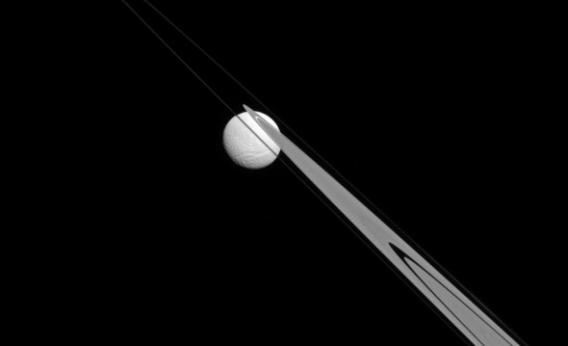Create a free profile to get unlimited access to exclusive videos, sweepstakes, and more!
Tethying Rings

So far over the past week or two I’ve covered a lot of ground in the solar system, from Mercury to Pluto, back to Mars, then in to the Sun.
So let’s head back out and see what’s going on at Saturn. Oh, just this:
Oh, do I love some good ol’ Saturn photo amazingness! What you’re seeing is Saturn’s moon Tethys right through Saturn’s rings, which are very nearly edge-on in this shot. The Cassini space probe was about 1.8 million kilometers (1.1 million miles) from Tethys when it took this.
You get a sense of just how thin the rings are here; although they’re hundreds of thousands of kilometers across, they’re only a few tens of meters thick! There are several subdivisions of rings, too. The thick band crossing Tethys is the A ring, and you can see the narrow Keeler gap (carved by the dinky moon Daphnis) also crossing Tethys’ face. Inside the A ring is the Cassini Division, then the broad B ring closer to Saturn. Outside the A ring, also seen crossing Tethys, is the narrow and frankly weird F ring. You can’t see it here, but the F ring is twisted and knotted by the gravitational interactions of the tiny moons Pandora and Prometheus.
Tethys is a pretty interesting place, too.
Tethys is a decently sized 1,062 km (660 miles) in diameter, but its average density is actually lower than water! Dump it into the Pacific Ocean and it would float … but it would also melt. It’s primarily made of water ice, a giant ice ball. You can see in this image (and in others) that the surface is rough and heavily cratered, but the only big topographical features are grabens, gigantic cracks in the surface which probably formed as the moon cooled and solidified long ago.
I love the perspective in this picture; compare the image above to this one taken at a much higher angle. That one makes Tethys look like it’s above the rings when it’s in fact aligned with them. The system of rings and moons around Saturn is constantly changing, as is Cassini’s angle on them, providing a never-ending parade of wonder. It’s a gorgeous solar system we live in, and I’m glad we live in a time when we can see that.














